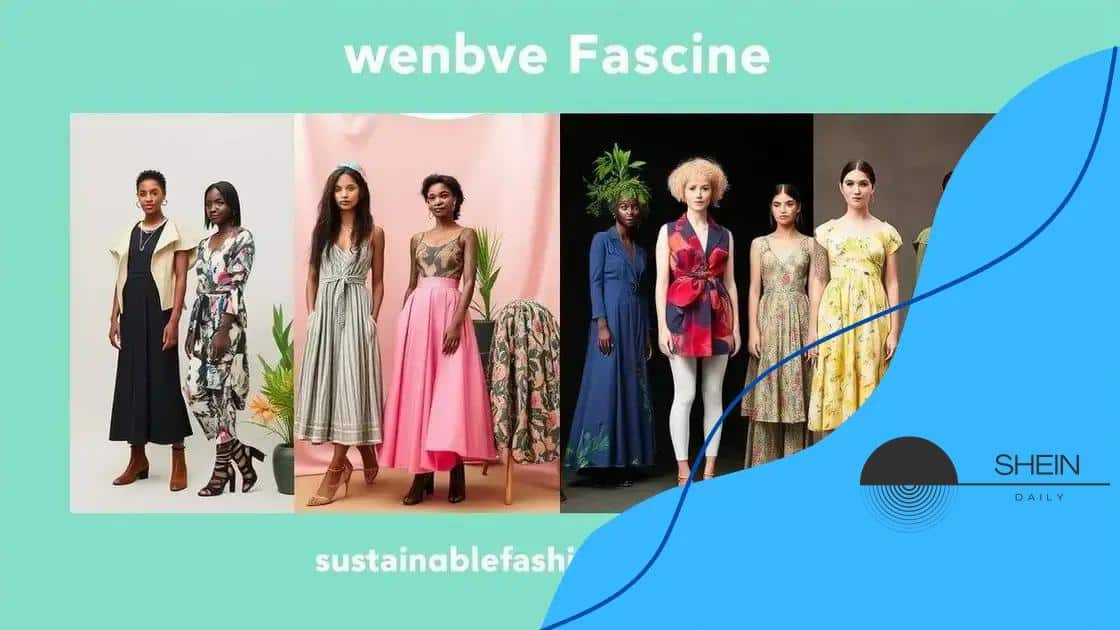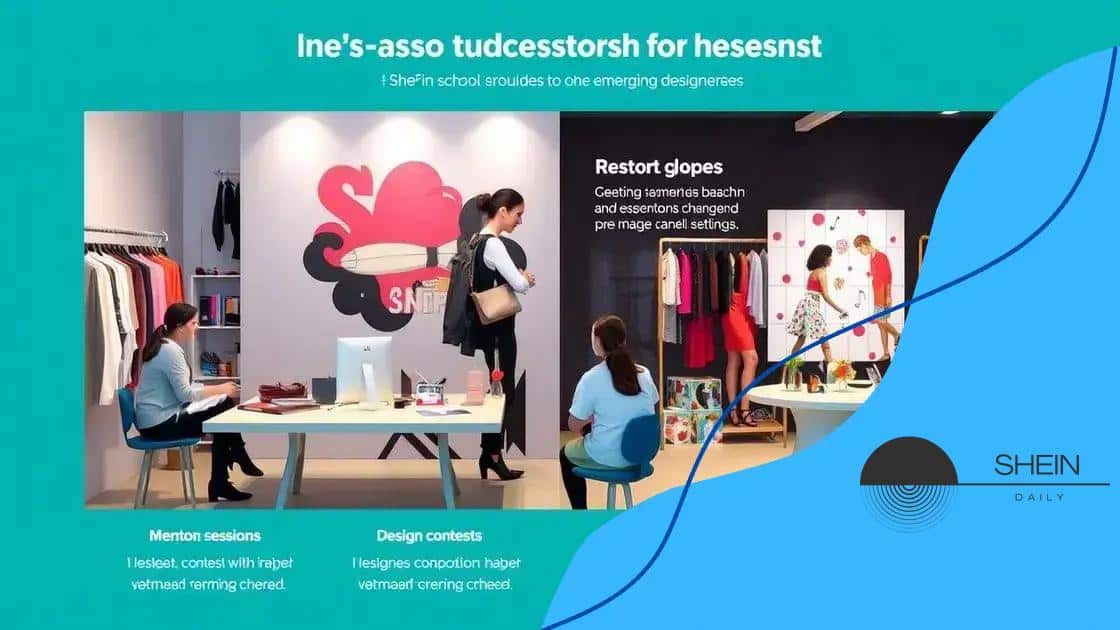Shein’s initiatives to improve fashion industry knowledge

Shein’s initiatives to improve fashion industry knowledge focus on sustainability education, mentorship for emerging designers, and technology integration to enhance learning experiences in the ever-evolving fashion landscape.
Shein’s initiatives to improve fashion industry knowledge are paving the way for a more informed approach to sustainable fashion. Ever wondered how fast fashion can align with education? Let’s delve into this intriguing topic.
Understanding Shein’s commitment to sustainability
Understanding Shein’s commitment to sustainability is essential for anyone interested in the future of fashion. The brand has made significant strides in addressing environmental concerns.
Shein’s Sustainability Goals
One of the key areas Shein is focusing on is transparency. The company aims to provide clear information about its manufacturing processes and supply chain. This commitment is vital in building trust with consumers.
Eco-Friendly Materials
Additionally, Shein is committed to using more eco-friendly materials. This includes:
- Recycled fabrics: Utilizing materials that reduce waste.
- Organic cotton: Choosing sustainable farming methods.
- Water-saving techniques: Implementing processes that minimize water usage.
These efforts not only help the environment but also enhance the quality of the clothing. Sustainable practices are becoming increasingly important in today’s fashion landscape.
Another vital aspect is Shein’s recycling program. Customers can send back old clothes for recycling, promoting a circular economy. This initiative not only reduces waste but also encourages consumers to be part of the sustainability movement.
Community Impact
Moreover, Shein engages in various community initiatives. By partnering with local organizations, the brand supports education and sustainability programs. This involvement reflects Shein’s broader vision of creating a positive impact.
Ultimately, Shein’s commitment to sustainability is a multifaceted approach that addresses critical issues in the fashion industry. As consumers, knowing these efforts can help us make informed choices about our purchases.
Innovative programs for fashion education
Innovative programs for fashion education have emerged as crucial tools in shaping the next generation of fashion leaders. These programs aim to equip students with the skills needed to navigate the rapidly changing fashion landscape.
Hands-On Learning Experiences
Many educational institutions are incorporating hands-on learning into their curriculums. This approach allows students to gain real-world experience while learning. These experiences can include:
- Internships: Partnering with brands like Shein for practical exposure.
- Workshops: Collaborating with industry professionals to develop skills.
- Project-based learning: Working on actual fashion projects, providing valuable feedback.
By engaging with actual scenarios, students can better understand the challenges and opportunities of the fashion industry.
Online Learning Platforms
Additionally, online learning platforms have made fashion education more accessible. Students from various locations can benefit from:
- Virtual classes: Learning from industry experts regardless of location.
- Flexible schedules: Balancing education with other commitments.
- Diverse modules: Covering various aspects of fashion, from design to marketing.
This innovation allows a broader audience to participate in fashion education. As a result, there’s a growing community of informed individuals ready to make their mark.
Moreover, some programs focus on sustainability and ethical practices. This emphasis on responsible fashion helps students grasp the importance of their choices. They learn to prioritize eco-friendly solutions in their design and production processes.
Collaboration with Industry Leaders
Collaboration between educational institutions and industry leaders is another powerful aspect of modern fashion education. When schools partner with brands, students benefit from mentorship and networking opportunities. They gain insights into the industry’s inner workings and practical skills not covered in traditional classrooms.
The combination of theoretical knowledge and practical experience creates well-rounded individuals who are ready to tackle the growing demands of the fashion sector.
How Shein supports emerging designers

How Shein supports emerging designers is a crucial topic in understanding the brand’s impact on the fashion industry. By providing resources and opportunities, Shein helps new talent flourish.
Mentorship Programs
One significant way Shein supports these designers is through mentorship programs. These initiatives connect emerging designers with experienced professionals. Through mentorship, designers receive valuable advice on:
- Design techniques: Gaining insights on improving their craft.
- Business strategies: Learning how to market their designs effectively.
- Networking opportunities: Building connections in the fashion world.
This support not only boosts their confidence but also prepares them for real challenges.
Design Contests and Collaborations
Shein also engages with emerging talent through various design contests. These competitions encourage creativity and innovation. Winners often receive:
- Financial support: Funding to bring their designs to life.
- Exposure: Showcasing their work on a large platform.
- Collaboration opportunities: Partnering with Shein to launch their collections.
Such contests provide a launchpad for many aspiring designers, helping them gain visibility in the competitive fashion industry.
In addition, Shein’s collaboration with local and international fashion schools demonstrates its commitment to nurturing talent. By partnering with these schools, Shein facilitates workshops and guest lectures led by industry experts. Students gain firsthand experience and insights into current fashion trends and practices.
Utilizing Technology
Furthermore, Shein leverages technology to support emerging designers. The brand’s online platform allows designers to showcase their work to a global audience. This digital presence is invaluable in today’s market, where visibility can lead to significant opportunities. By utilizing social media and e-commerce, designers can engage directly with potential customers and receive feedback.
Through these various initiatives, Shein plays an essential role in fostering new talent in the fashion world. The brand’s commitment to supporting emerging designers not only enriches its offerings but also paves the way for a more diverse and innovative fashion future.
Impact of Shein on the global fashion ecosystem
The impact of Shein on the global fashion ecosystem is significant and multifaceted. As a major player in fast fashion, Shein is changing how consumers, designers, and retailers interact.
Redefining Fast Fashion
Shein’s approach to fast fashion emphasizes speed and affordability. By leveraging advanced technology and supply chain efficiencies, Shein can release new styles quickly. This rapid turnover leads to:
- Increased consumer demand: Shoppers are constantly drawn to new arrivals.
- Shorter product life cycles: Trends can emerge and fade faster than ever.
- A new retail model: Other brands are adapting to compete with Shein’s business model.
This shift is reshaping the shopping habits of consumers globally.
Environmental Concerns
However, the impact of Shein is not without controversy. The fast fashion model raises several environmental concerns. The production of clothing creates a substantial amount of waste and pollution. With more clothes produced, the demand for sustainable practices has increased. Consumers are becoming more aware of the importance of sustainability, pushing brands to consider their environmental footprints.
Influencing Trends
Moreover, Shein has a powerful influence on fashion trends around the world. By analyzing consumer data and social media feedback, Shein can quickly adapt its offerings. This agility allows them to set trends instead of merely following them. As a result:
- Emerging trends: New styles can become popular almost overnight.
- Global reach: Fashion influences can span across different cultures and markets.
- Social media impact: Influencers collaborating with Shein amplify trend visibility.
In many ways, Shein is shaping the narrative of what is fashionable today, affecting how fashion is perceived across different demographics.
Economic Contributions
Additionally, Shein contributes economically by creating numerous job opportunities worldwide. From customer service roles to supply chain management, the brand supports various sectors. This contribution bolsters local economies and provides pathways for employment in regions where opportunities may be limited.
Overall, the impact of Shein on the global fashion ecosystem reflects a complex interplay of innovation, environmental challenges, and economic contributions. As the brand continues to evolve, so will its influence on the industry.
Future trends in fashion knowledge initiatives
Future trends in fashion knowledge initiatives show exciting possibilities for education and collaboration in the industry. As the fashion landscape continues to change, so do the ways in which knowledge is shared and developed.
Increased Emphasis on Sustainability
One major trend is a growing focus on sustainability within fashion education. Programs will likely include:
- Eco-friendly practices: Teaching students about sustainable materials and production methods.
- Ethical fashion: Exploring the social implications of the fashion industry.
- Recycling and upcycling: Encouraging innovative ideas for reusing materials.
This emphasis ensures future designers are equipped to create responsibly.
Online Learning and Virtual Engagement
Another trend is the expansion of online learning platforms. With the rise of digital education, students can access:
- Webinars and online courses: Learning from top experts without geographical limitations.
- Virtual workshops: Hands-on experience in a remote format.
- Interactive communities: Engaging with peers and professionals from around the world.
This shift allows for a more diverse learning environment and helps break down barriers in education.
Collaboration Between Brands and Institutions
Collaboration between fashion brands and educational institutions will become more vital. By partnering in initiatives, brands can:
- Support research: Funding studies that drive innovation.
- Participate in curriculum design: Ensuring students learn relevant skills.
- Offer internships and scholarships: Providing opportunities for real-world experience.
Such collaborations empower students and enhance their readiness for the marketplace.
As technology advances, we can expect to see more integration of tools like augmented reality and artificial intelligence in fashion education. These technologies can create immersive learning experiences that better prepare students for modern challenges in the industry. For example, virtual reality could allow students to experience fashion shows and presentations as if they were there.
Overall, these future trends will shape a new generation of fashion professionals who are knowledgeable, innovative, and responsible.
In conclusion, Shein’s initiatives to enhance fashion industry knowledge are transforming the way we think about sustainability, education, and designer support. By prioritizing eco-friendly practices and collaborating with local schools, they help shape a new generation of informed fashion professionals. Moreover, the integration of technology in learning and industry engagement is setting new standards for what it means to be part of the fashion world. As we look to the future, these trends will continue to influence how we create, consume, and understand fashion.
FAQ – Frequently Asked Questions about Shein’s Initiatives in Fashion Education
What role does Shein play in promoting sustainability?
Shein emphasizes eco-friendly practices in its supply chain and supports educational programs focused on sustainable fashion.
How does Shein support emerging designers?
Shein offers mentorship programs, design contests, and collaboration opportunities to help new designers gain experience and visibility.
What are the future trends in fashion education?
Future trends include a focus on sustainability, increased online learning opportunities, and partnerships between brands and educational institutions.
How is technology shaping fashion education?
Technology is enhancing learning experiences through online courses, virtual workshops, and tools that allow for interactive education.





